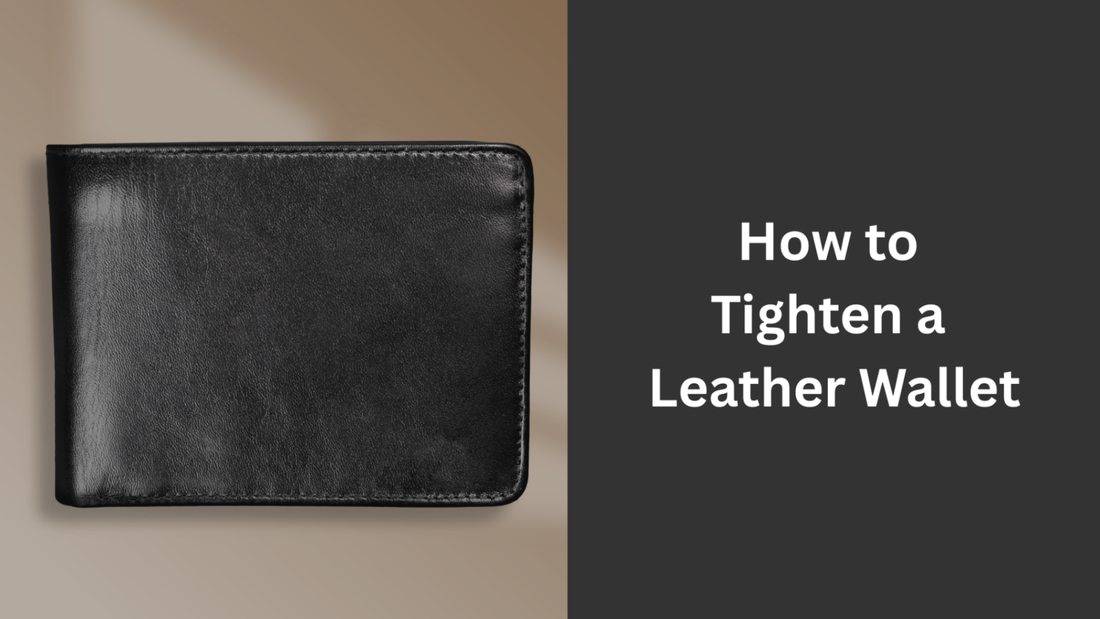
How to Tighten a Leather Wallet: Quick & Easy Fixes
If you’ve noticed your wallet feeling too floppy or if your cards are sliding out too easily, don’t worry. You don’t have to toss it out and buy a new one. In fact, tightening a leather wallet is completely possible with a few simple methods that help bring it back to a firm, compact shape.
In this guide, we’ll walk you through how to tighten a leather wallet effectively—whether it’s a bifold, trifold, or minimalist cardholder.

Why Do Leather Wallets Stretch?
Before jumping into the solutions, let’s understand the root of the problem.
Leather is a natural material, and it stretches over time—especially when exposed to heat, moisture, and pressure. If you’ve ever stuffed your wallet with extra cards, receipts, or coins, chances are you’ve loosened up the structure.
Common reasons leather wallets stretch include:
-
Carrying too many items for long periods
-
Repeated friction from sitting on it in your back pocket
-
Heat and humidity softening the leather
-
Improper cleaning or conditioning
-
Leaving it under pressure (like in tight jeans)
Now, let’s go over how to reverse that damage.
1. Empty and Assess the Wallet
The first step is to remove everything from your leather wallet—cards, cash, coins, receipts, even hidden bits in side pockets. You want the leather to sit naturally so you can check the shape and stretch.
Once empty, check:
-
Are the card slots loose?
-
Is the wallet bulging or misshaped?
-
Are corners soft and flimsy?
This gives you a clear idea of where tightening is needed.
2. Let It Rest (Natural Shrink Method)
Leather has a memory. If it’s not being stretched constantly, it slowly begins to tighten on its own.
Here’s what you can do:
-
Store the empty wallet in a cool, dry place for 2–3 days.
-
Place a light weight (like a book) on top to gently compress it.
-
Do not expose it to direct sunlight or use a hair dryer.
This rest period can cause the leather fibers to contract slightly. It’s a safe and natural method that works best for minor stretching.

3. Use the “Warm Water Compression” Method
If natural resting isn’t enough, a slightly more advanced technique is using water and compression.
⚠️ Important: Always test a small spot first to ensure your wallet’s leather doesn’t react badly.
Steps:
-
Dampen a soft cloth with lukewarm water—don’t soak it.
-
Gently wipe the stretched areas of the wallet (like card slots or folds).
-
While the wallet is slightly damp (not wet), place it under a heavy book or between two flat surfaces.
-
Leave it compressed overnight.
This helps tighten up the leather fibers. Just make sure the wallet is never dripping wet—too much water can damage leather.
4. Use a Leather Conditioner (Strategically)
Sometimes, tightening isn’t just about shrinkage—it’s about firming up the leather.
A good leather conditioner:
-
Strengthens leather fibers
-
Adds a bit of stiffness
-
Keeps it from becoming floppy or too soft
Apply a small amount of conditioner (like Lexol or Leather Honey) to the outer surface and inside folds. Let it soak in and then buff gently with a cloth.
This won’t shrink the leather, but it will help restore structure and shape, especially on older wallets.
5. Insert Fewer Cards Strategically
This step sounds obvious, but it’s crucial if you don’t want the wallet to stretch out again after tightening.
Try these tips:
-
Use only essential cards (ID, debit, credit)
-
Store coins in a separate pouch
-
Rotate cards between slots to avoid permanent widening
Over time, if you let unused slots remain empty, they naturally shrink back closer to their original size.
6. Try the Elastic Band Technique
If your card slots are stretched, and cards are slipping out, try this quick DIY method:
What you need:
-
A couple of credit cards
-
A rubber band or hair tie
What to do:
-
Insert 2–3 cards into the loose slot
-
Wrap a tight elastic band around the wallet (like a money clip)
-
Leave it overnight or for 24 hours
The pressure will help the slots mold back to a snug fit around card size. It’s a budget-friendly trick that surprisingly works well.
7. Professional Help (Optional)
If your leather wallet is a premium designer piece or has sentimental value, and the stretching is severe, consider taking it to a leather repair expert or shoe/luggage repair shop.
They may use:
-
Heat presses
-
Professional shrinkage sprays
-
Reinforcement stitching
It costs more but ensures the wallet is restored safely without cracking or damage.
Pro Tips to Prevent Future Stretching
Once your wallet is tightened, you’ll want to keep it that way. Here’s how:
-
Avoid overstuffing—stick to 4–6 cards max
-
Rotate use between different wallets
-
Store flat in a drawer instead of your pocket overnight
-
Use a wallet insert if needed to maintain shape
-
Clean and condition every 2–3 months
Remember: a well-kept leather wallet can last for decades. Treat it right, and it’ll continue to age like fine wine.
Final Thoughts
Your leather wallet doesn't have to stay stretched or shapeless forever. With the right care techniques—natural resting, gentle water compression, leather conditioning, and smart storage—you can tighten your leather wallet and restore its original feel and fit.
Whether it’s a classic bifold or a minimalist cardholder, these simple DIY methods give your favorite leather accessory a second life. Plus, learning how to maintain your wallet properly means you’ll save money and keep looking sharp.
So go ahead—empty that overstuffed wallet, show it some love, and let it bounce back to its firm and stylish self!





